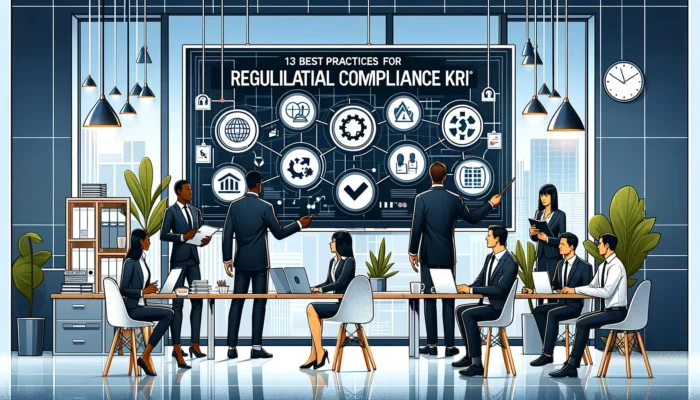Regulatory compliance ensures that companies adhere to relevant laws and regulations, protecting both the organization and its stakeholders.
One way to ensure compliance is by implementing Key Risk Indicators (KRIs). KRIs are metrics that help organizations measure and monitor risks associated with regulatory compliance.
Implementing best practices for regulatory compliance KRIs is essential for organizations that want to manage risk effectively. First, it is crucial to identify the KRIs that are relevant to the organization and its regulatory requirements.
Each organization has unique regulatory requirements, and KRIs should be tailored to reflect these requirements. Second, monitoring risks in real time is critical to identifying and mitigating potential risks effectively.
KRIs should be monitored regularly to ensure that they remain relevant and effective in mitigating risks.
Finally, it is important to have a robust reporting system in place to ensure that the right people receive the right information at the right time.
Reports should be tailored to the audience, and KRIs should be presented in a way that is easy to understand.

Organizations can effectively manage risks associated with regulatory compliance by implementing best practices for regulatory compliance KRIs, and protect themselves and their stakeholders.
Understanding Regulatory Compliance and KRIs
Regulatory compliance refers to the adherence to laws, regulations, and standards set by governing bodies, industry associations, and other regulatory bodies.
Organizations must comply with these regulations to avoid legal and financial penalties, safeguard their reputation, and maintain a strong ethical standing within their respective industries.
Key Risk Indicators (KRIs) are metrics used to measure and monitor risks that can impact an organization’s ability to meet regulatory compliance requirements.
KRIs provide a proactive approach to risk management by identifying potential risks before they become a problem. KRIs are essential in developing a comprehensive risk profile and analyzing exposure over time to ensure regulatory compliance.
Organizations use KRIs to identify potential risks and appropriate key risk indicators (KRIs) to monitor those risks. KRIs can be qualitative or quantitative in nature and are often used in conjunction with other risk management tools such as risk assessments, risk registers, and risk dashboards.
Some examples of KRIs used in regulatory compliance include:
- Compliance with legal and regulatory requirements.
- Timely and accurate reporting.
- Adherence to internal policies and procedures.
- Protection of confidential and sensitive information.
- Identification and mitigation of potential conflicts of interest.
- Effective management of third-party relationships.
Organizations can safeguard their reputation and maintain ethical standing by proactively utilizing KRIs to mitigate risks.
Importance of KRIs in Risk Management
Key Risk Indicators (KRIs) are essential components of a robust risk management strategy. They help organizations identify, assess, and monitor potential risks that may affect their ability to meet regulatory requirements and achieve their business objectives.
Organizations can proactively manage and mitigate risks with KRIs.
KRIs play a critical role in enterprise risk management by providing a structured approach to risk identification, assessment, and management.
They help organizations establish a risk appetite and develop a risk management system that aligns with their business objectives.
KRIs also facilitate risk assessments by providing a framework for measuring and monitoring risk exposure, risk profile, and risk events.
Effective KRI implementation requires a thorough understanding of the potential risks that an organization may face.
This involves conducting a comprehensive risk assessment to identify and prioritize risks based on their likelihood and potential impact. Once risks are identified, KRIs can be developed to measure and monitor the identified risks.
KRIs should be specific, measurable, and relevant to the risks being monitored. They should also align with the organization’s risk management strategy and culture.
KRIs can be quantitative or qualitative and can be derived from a range of sources, including financial data, operational metrics, and external data sources.
KRIs are vital in managing risk and achieving regulatory compliance. They provide organizations with a structured approach to risk identification, assessment, and management, enabling them to manage potential risks proactively.
Effective KRI implementation requires a thorough understanding of the potential risks and a robust risk management system that aligns with the organization’s risk appetite and culture.
Key Metrics and Indicators
When it comes to regulatory compliance, organizations must keep track of various metrics and indicators to ensure that they are meeting regulatory requirements. This will cover two key types of metrics and indicators: Key Risk Indicators (KRIs) and Key Performance Indicators (KPIs).
Key Risk Indicators
KRIs are measurements used to assess and monitor potential risks that may affect an organization’s ability to meet regulatory requirements. Identifying KRIs is a crucial step in ensuring regulatory compliance [1]. Some examples of KRIs include:
- A number of regulatory violations.
- Number of customer complaints.
- Percentage of employees trained on compliance policies.
- Percentage of compliance audits passed.
Organizations must carefully select KRIs that are relevant to their specific industry and compliance requirements. By monitoring KRIs, organizations can proactively identify potential compliance issues and take corrective action before they become major problems.
Key Performance Indicators
KPIs are measurements used to evaluate an organization’s performance against specific goals and objectives. In the context of regulatory compliance, KPIs can be used to measure the effectiveness of an organization’s compliance program. Some examples of KPIs include:
- Percentage of compliance training completed by employees.
- Percentage of compliance audits passed.
- Time to resolve compliance issues.
- Number of compliance violations detected by internal audits.
Organizations must carefully select KPIs that align with their compliance goals and objectives. By monitoring KPIs, organizations can gain insights into the effectiveness of their compliance program and make data-driven decisions to improve it.
In conclusion, identifying and monitoring KRIs and KPIs is essential for ensuring regulatory compliance. Organizations must carefully select relevant metrics and indicators and use them to proactively identify potential compliance issues and measure the effectiveness of their compliance program.
[1] 13 Best Practices For Regulatory Compliance KRI [2] Compliance Metrics and KPIs For Measuring Compliance Effectiveness
Technology and Automation in Compliance KRIs
Technology and automation are playing an increasingly important role in regulatory compliance KRIs. Companies are using technology to automate the process of identifying and monitoring KRIs.
This has led to more accurate and timely identification of potential compliance issues and improved risk management.
One of the most significant benefits of technology and automation in compliance KRIs is the ability to create dashboards that provide real-time data.
These dashboards can be used to monitor compliance metrics and identify potential issues before they become major problems. This is particularly important in industries such as finance and healthcare, where compliance is critical.
Analytics is another important aspect of technology in compliance with KRIs. Companies can use analytics to identify patterns and trends in compliance data, which can help them identify potential issues before they become significant problems.
For example, analytics can be used to identify trends in cyber attacks, which can help companies take steps to prevent future attacks.
Cybersecurity is also an essential aspect of technology and automation in compliance KRIs. Companies must ensure that their systems are secure and protected from cyber threats. Failure to do so can result in significant fines and reputational damage.
In conclusion, technology and automation are critical components of regulatory compliance KRIs. Companies are using technology to automate the process of identifying and monitoring KRIs, creating dashboards that provide real-time data, and using analytics to identify patterns and trends.
Cybersecurity is also an essential aspect of technology and automation in compliance KRIs. Companies must ensure that their systems are secure and protected from cyber threats.
Risk Monitoring and Reporting
Once an organization has identified its key risk indicators (KRIs), it is essential to monitor them regularly. This monitoring process helps organizations identify potential risks and take corrective actions before they escalate into major issues.
Monitoring of KRIs can be done through various tools and techniques, including automated systems, manual tracking, and regular reporting.
Automated systems can help organizations track KRIs in real-time, which can provide early warning signs of potential risks. Manual tracking can involve regular reviews of KRIs to identify any changes or trends that may indicate potential risks.
Regular reporting can help organizations keep stakeholders informed about the status of KRIs and any changes that may impact regulatory compliance.
Organizations can use a risk register to monitor KRIs and track their progress over time. A risk register is a tool that helps organizations identify, assess, and prioritize risks. It can also help organizations track the status of KRIs and take corrective actions when necessary.
Reporting is an essential part of risk monitoring. Organizations need to have a clear reporting structure in place to ensure that stakeholders are informed about the status of KRIs.
Reports should be concise, clear, and easy to understand. They should provide information about the current status of KRIs, any changes or trends that may indicate potential risks, and any corrective actions that have been taken.
In conclusion, risk monitoring and reporting are essential components of implementing regulatory compliance KRIs. Organizations should use a risk register to monitor KRIs and track their progress over time.
They should also have a clear reporting structure in place to ensure that stakeholders are informed about the status of KRIs. Automated systems, manual tracking, and regular reporting can be used to monitor KRIs effectively.
Assessment and Identification of Risks
Implementing regulatory compliance KRIs requires a comprehensive risk assessment process that identifies potential risks and analyzes exposure over time.
The first step in this process is to assess the organization’s risk profile, which involves identifying all the potential risks that the organization could face.
Once the risk profile has been established, the next step is to identify the key risk indicators (KRIs) that will be used to monitor and measure the organization’s exposure to these risks.
KRIs are specific metrics that provide early warning signs of potential problems and help organizations take corrective action before a risk becomes a major issue.
Risk assessments are an essential part of the regulatory compliance process, as they help organizations identify areas of weakness and potential vulnerabilities. They are also important for ensuring the organisation complies with all relevant regulations and legislation.
The risk identification process involves identifying all the potential risks that the organization could face, including legal and regulatory compliance risks.
This process should be conducted by a team of experts who deeply understand the organization’s operations and the regulatory environment in which it operates.
The risk assessment process should also take into account the potential impact of each risk on the organization, as well as the likelihood of the risk occurring.
This information can then be used to prioritize risks and determine which KRIs should be monitored more closely.
Assessing and identifying risks is a critical component of implementing regulatory compliance KRIs. By conducting a comprehensive risk assessment process, organizations can identify potential risks and take proactive steps to mitigate them before they become major issues.

Mitigating Risks and Ensuring Compliance
One of the most critical aspects of regulatory compliance is mitigating compliance risks. Compliance risks refer to the potential for an organization to violate laws and regulations that govern its operations.
Failure to comply with these laws and regulations can result in significant fines, legal penalties, and reputational damage. Therefore, it is essential for organizations to implement best practices for mitigating compliance risks.
One of the best ways to mitigate compliance risks is to implement a Key Risk Indicators (KRI) program. KRIs are measurements used to assess and monitor potential risks that may affect an organization’s ability to meet regulatory requirements.
A KRI program can help organizations detect potential compliance risks in advance and take necessary measures to prevent them.
Organizations should follow best practices for regulatory compliance to effectively implement a KRI program. These best practices include identifying and assessing compliance risks, developing strategies for mitigating risks, and monitoring compliance risks on an ongoing basis.
Organizations should also ensure that they have adequate resources and personnel to implement and maintain their KRI program.
Another critical aspect of mitigating compliance risks is ensuring that organizations are compliant with applicable laws and regulations.
Compliance with laws and regulations is essential for avoiding non-compliance penalties and reputational damage. Organizations should implement best practices for regulatory compliance, such as conducting regular compliance risk assessments, developing compliance policies and procedures, and providing training to employees on compliance requirements.
In conclusion, mitigating compliance risks and ensuring regulatory compliance is critical for organizations to avoid legal penalties, reputational damage, and financial losses.
Implementing best practices for regulatory compliance and developing a KRI program, organizations can proactively identify and mitigate potential compliance risks.
Impact of Regulatory Changes
Regulatory changes can significantly impact an organization’s ability to meet regulatory requirements. Failure to comply with these changes can lead to a range of penalties, including fines and legal action.
Therefore, it is essential to stay up-to-date with regulatory changes and their implications.
One of the best ways to stay on top of regulatory changes is to use key risk indicators (KRIs). Kris can help identify potential risks associated with new regulations, allowing organizations to take proactive measures to mitigate those risks.
For example, if a new regulation requires additional reporting or record-keeping, an organization can use KRIs to monitor compliance with those requirements.
Another way to manage the impact of regulatory changes is to conduct regular risk assessments. Risk assessments can help identify potential areas of non-compliance and prioritize efforts to address those risks.
Organizations can use KRIs to monitor the effectiveness of their risk management efforts and adjust their approach as necessary.
Regulatory pressure can also significantly impact an organization’s compliance efforts. As regulatory requirements become more complex and demanding, organizations may struggle to keep up.
However, with the right tools and strategies, organizations can manage regulatory pressure and maintain compliance.
One effective strategy for managing regulatory pressure is to implement a compliance management system (CMS). A CMS can help organizations streamline their compliance efforts, reducing the burden of regulatory requirements.
Additionally, a CMS can provide a framework for continuous improvement, allowing organizations to proactively identify and address compliance gaps.
The impact of regulatory changes and pressure on an organization’s compliance efforts cannot be overstated. However, with the right tools and strategies, organizations can manage these challenges effectively and maintain compliance.
Best Practices for Implementing Compliance KRIs
Implementing Key Risk Indicators (KRIs) for regulatory compliance can be challenging, but it can be done efficiently and effectively with the right approach. Here are some best practices for implementing compliance KRIs:
1. Identify the Key Risk Indicators (KRIs)
The first step in implementing KRIs is to identify the most relevant ones for your organization. This involves understanding the regulatory requirements your organisation must comply with and identifying the risks associated with non-compliance.
Once the risks are identified, it is important to select the KRIs that are most relevant to your organization and that will help you monitor and manage those risks.
2. Develop a KRI Framework
Once the KRIs have been identified, developing a framework for monitoring and reporting them is important. This framework should include the frequency of monitoring, the thresholds for each KRI, and the reporting requirements. It is also important to establish clear responsibilities for monitoring and reporting the KRIs.
3. Integrate KRIs into the Compliance Program
KRIs should be integrated into the organization’s overall compliance program. This means that they should be included in policies and procedures, training programs, and risk assessments.
It is also important to ensure that the KRIs are regularly reviewed and updated to reflect changes in the regulatory environment.
4. Use Technology to Monitor KRIs
Technology can be a powerful tool for monitoring and reporting KRIs. There are many software solutions available that can help automate the process of monitoring and reporting KRIs.
These solutions can provide real-time monitoring, alerts, and dashboards to help organizations maintain compliance obligations.
5. Continuously Evaluate and Improve KRIs
Finally, it is important to evaluate and improve the KRIs continuously. This involves monitoring the effectiveness of the KRIs in identifying and managing risks and making adjustments as needed.
It is also important to stay up-to-date with changes in the regulatory environment and adjust the KRIs accordingly.
Organizations can effectively manage regulatory risks and ensure compliance by implementing these best practices for compliance KRIs.

Conclusion
Implementing regulatory compliance Key Risk Indicators (KRIs) is crucial for businesses to manage and mitigate potential risks that may affect their ability to meet regulatory requirements.
Businesses can prevent losses and breaches by monitoring key risk indicators.
To effectively implement regulatory compliance KRIs, businesses need to ensure that their decision-making processes involve all stakeholders, including senior management, management teams, and internal auditors.
They must allocate resources and establish benchmarks and measurable thresholds to monitor their exposure to operational and market risks.
It is essential to have a controlled environment that ensures that internal controls are in place to prevent and detect fraud and to have a business continuity and disaster recovery plan in case of natural disasters or system failures.
Businesses need to assess their level of risk tolerance and establish tolerances for losses and mistakes.
To ensure efficiency and customer satisfaction, businesses need to establish action plans to address root causes and emerging threats. They need to monitor their supply chains and third-party risk and establish comparable metrics to measure their performance. They also need to comply with ASIC regulations to avoid fines.
In summary, implementing regulatory compliance KRIs is an ongoing process that requires businesses to allocate personnel and resources to ensure that their operations comply with regulatory requirements. By establishing a predictive and quantifiable approach to risk management, businesses can ensure that their business objectives are met while maintaining a secure and compliant environment.

Chris Ekai is a Risk Management expert with over 10 years of experience in the field. He has a Master’s(MSc) degree in Risk Management from University of Portsmouth and is a CPA and Finance professional. He currently works as a Content Manager at Risk Publishing, writing about Enterprise Risk Management, Business Continuity Management and Project Management.

